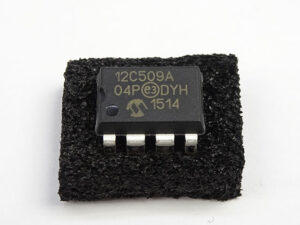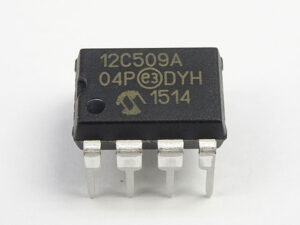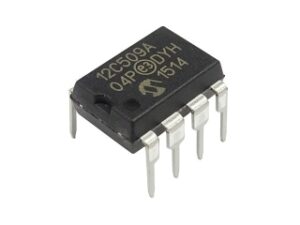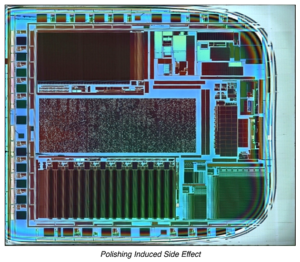 Reverse Engineering Microcontroller PIC12C509A Binary
Reverse Engineering Microcontroller PIC12C509A Binary
The PIC12C509A is commonly used in embedded systems, from consumer electronics to automotive applications. However, many of these systems are designed with protective measures to prevent unauthorized access. Our service allows you to break through these security layers and retrieve the underlying source code from the binary or heximal firmware files.
Whether your goal is to clone, duplicate, or copy the firmware, our team employs advanced reverse engineering techniques to attack the secured binary data. This process often involves disassembling the firmware, analyzing the program logic, and extracting meaningful data that can be re-engineered for further use. We can help unlock the hidden secrets within the firmware to make necessary adjustments, fix bugs, enhance functionality, or perform security audits.

Der PIC12C509A wird häufig in eingebetteten Systemen verwendet, von der Unterhaltungselektronik bis hin zu Automobilanwendungen. Viele dieser Systeme sind jedoch mit Schutzmaßnahmen ausgestattet, um unbefugten Zugriff zu verhindern. Unser Service ermöglicht es Ihnen, diese Sicherheitsebenen zu durchbrechen und den zugrunde liegenden Quellcode aus den binären oder hexadezimalen Firmwaredateien abzurufen.
Ganz gleich, ob Ihr Ziel darin besteht, die Firmware zu klonen, zu duplizieren oder zu kopieren, unser Team verwendet fortschrittliche Reverse-Engineering-Techniken, um die gesicherten Binärdaten anzugreifen. Dieser Prozess umfasst häufig das Zerlegen der Firmware, das Analysieren der Programmlogik und das Extrahieren aussagekräftiger Daten, die für die weitere Verwendung neu entwickelt werden können. Wir können Ihnen helfen, die verborgenen Geheimnisse der Firmware zu entschlüsseln, um notwendige Anpassungen vorzunehmen, Fehler zu beheben, die Funktionalität zu verbessern oder Sicherheitsprüfungen durchzuführen.
Our Expertise in Handling Secured Data
Our reverse engineering service for the PIC12C509A binary involves using the latest tools and methods to open locked firmware, decrypt protected data, and extract the source code. By doing so, we provide a reliable solution to ensure you can make informed decisions about your embedded system, whether it’s for customization, repair, or vulnerability testing.

Нашата услуга за обратно инженерство за двоичния PIC12C509A включва използването на най-новите инструменти и методи за отваряне на заключен фърмуер, дешифриране на защитени данни и извличане на изходния код. Правейки това, ние предоставяме надеждно решение, за да гарантираме, че можете да вземате информирани решения относно вашата вградена система, независимо дали става въпрос за персонализиране, поправка или тестване на уязвимости.
Conclusion
If you’re struggling with locked or encrypted PIC12C509A firmware, our team is here to help. We can reverse engineer your microcontroller’s binary to restore functionality, break protective layers, and give you the tools to control and modify your embedded system. Contact us today to discuss your reverse engineering needs.

Nếu bạn đang gặp khó khăn với chương trình cơ sở PIC12C509A bị khóa hoặc mã hóa, nhóm của chúng tôi ở đây để giúp bạn. Chúng tôi có thể đảo ngược kỹ thuật nhị phân của bộ vi điều khiển của bạn để khôi phục chức năng, phá vỡ các lớp bảo vệ và cung cấp cho bạn các công cụ để kiểm soát và sửa đổi hệ thống nhúng của bạn. Liên hệ với chúng tôi ngay hôm nay để thảo luận về nhu cầu kỹ thuật đảo ngược của bạn.
PIC12C5XX memory is organized into program memory and data memory to facilitate the process of Reverse Engineering Microcontroller PIC12C509A Binary. For devices with more than 512 bytes of program memory, a paging scheme is used.
Program memory pages are accessed using one STATUS register bit. For the PIC12C509, PIC12C509A, PICCR509A and PIC12CE519 with a data memory register file of more than 32 registers, a banking scheme is used. Data memory banks are accessed using the File Select Register (FSR) for the purpose of Recover Chip PIC16F83 Eeprom.
The PIC12C5XX devices have a 12-bit Program Counter (PC) capable of addressing a 2K x 12 program memory space. Only the first 512 x 12 (0000h-01FFh) for the PIC12C509A and 1K x 12 (0000h-03FFh) for the PIC12C509, PIC12C509A, PIC12CR509A, and PIC12CE519 are physically implemented.
Refer to Figure 4-1. Accessing a location above these boundaries will cause a wrap around within the first 512 x 12 space (PIC12C509A) or 1K x 12 space (PIC12C509A) if Reverse engineering Microcontroller. The effective reset vector is at 000h, (see Figure 4-1). Location 01FFh (PIC12C508, PIC12C508A and PIC12CE518) or location 03FFh (PIC12C509, PIC12C509A, PIC12CR509A and PIC12CE519) contains the internal clock oscillator calibration value. This value should never be overwritten when Reverse Engineering Microcontroller PIC16C717 Program.
As a program instruction is executed, the Program Counter (PC) will contain the address of the next program instruction to be executed. The PC value is increased by one every instruction cycle, unless an instruction changes the PC.
For a GOTO instruction, bits 8:0 of the PC are provided by the GOTO instruction word. The PC Latch (PCL) is mapped to PC<7:0>. Bit 5 of the STATUS register provides page information to bit 9 of the PC (Figure 4- 8).For a CALL instruction, or any instruction where the PCL is the destination, bits 7:0 of the PC again are provided by the instruction word. However, PC<8> does not come from the instruction word, but is always cleared.

Reverse Engineering Microcontroller PIC12C509A Binary
Instructions where the PCL is the destination, or Modify PCL instructions, include MOVWF PC, ADDWF PC, and BSF PC,5. The Program Counter is set upon a RESET, which means that the PC addresses the last location in the last page i.e., the oscillator calibration instruction. After executing MOVLW XX, the PC will roll over to location 00h, and begin executing user code through Break IC PIC16C711 Program.
The STATUS register page preselect bits are cleared upon a RESET, which means that page 0 is pre-selected. Therefore, upon a RESET, a GOTO instruction will automatically cause the program to jump to page 0 until the value of the page bits is altered by Crack MCU.